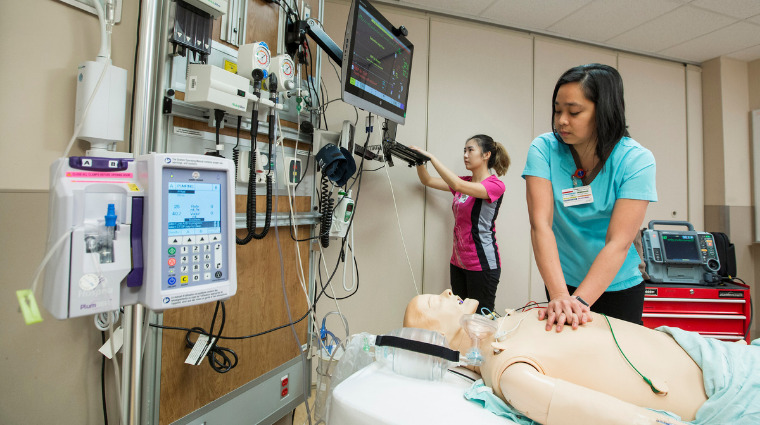
Healthcare practices are fast-paced and professionals must often make split-second decisions in life or death situations. Training and practical experience prepare healthcare professionals for these high-pressure situations. At Saskatchewan Polytechnic, simulation labs with a variety of equipment including specialized mannequins are utilized to provide students with realistic experiences in a controlled environment. Simulations are fully immersive and interactive which enables learners to be more involved in the near real-life scenarios.
“As a student, critical experiences are not always available in the clinical setting. The simulation labs provide practice with those critical experiences without exposing a patient or the student to harm,” says Madeline Press, director for the Centre for Health Research, Improvement and Scholarship at Sask Polytech. “Simulation used in preparing healthcare students helps the students to learn vital skills and develop clinical reasoning and confidence in a safe, controlled environment.”
Over 2,000 students in various programs including nursing, paramedics, policing and more utilize the labs each year. Hands-on training in a realistic environment is essential for healthcare learning; Sask Polytech’s simulation centres are set up to look like and feel like a real healthcare environment with beds, equipment and furniture that you would find in a hospital setting. “The more realistic we can make the environment, the easier it is for the student to transfer their learning to the clinical environment. This results in a more prepared and better educated student,” says Press.
Simulation labs require new and evolving technologies to provide the most realistic and evolutionary training for healthcare learners. Sask Polytech has simulation labs in Prince Albert, Regina and Saskatoon. Each lab is equipped with different technologies based on the programs served at each campus. The equipment ranges from consumable supplies such as oxygen therapy equipment and IV insertion supplies, to electronics, audio visual equipment and specialized mannequins.
Simulation mannequins create a more realistic clinical scenario to aid learners. Sask Polytech has a variety of low, mid and high fidelity adult and pediatric mannequins, some of which can be intubated, simulate traumatic bleeding and have CPR analysis. The simulators are incredibly life-like with the feel of real tissue.
The higher the level of fidelity, the more closely the healthcare simulation matches real life situations. With expanding chests that breathe, variable heart rates and tones, measurable blood pressure and the ability to give birth, among other things, high fidelity mannequins are the most life-like.
A simulation technologist operates these mannequins from a separate control room to monitor and make changes to the simulator as the session progresses. This allows learners the opportunity to respond to changes in the mannequin, not instructor cues.
Although the Sask Polytech simulation centres were able to retire four aging mannequins this Spring and acquire two new ones, as technology changes, there is a continuous need to update resources in the labs to ensure there is no gap in training. Sask Polytech works hard to ensure students have the most up to date technology. “High fidelity mannequins have an eight to 10-year life span,” says Nicole Wiens, program head, Simulation Centre. “Just like any other computer, their technology becomes aged and slows over time.”
In addition to utilizing simulation labs for training, Sask Polytech is also now incorporating virtual simulation. Virtual reality scenarios are delivered through web-based platforms which allow students access from home. Sask Polytech has developed virtual simulation training for dressing changes and viewing operating room and a laparoscopic cholesectomy being performed on a patient. Augmented reality programs place a virtual environment over the real environment. For example, students are able to see the internal processes of the human body while practicing placement of IVs. The opportunity to practice scenarios as many times as the student would like has a major impact on the effectiveness of virtual simulation.
Simulations allow students to become confident in high-pressure situations, learn from their mistakes in a safe and supportive environment, and gain experience with conditions they may not encounter during clinical. These experiences translate into better care for patients when students graduate and enter their chosen profession. As healthcare continues to evolve and become more complex, Sask Polytech is focused on forging best practices and advancements in technology which are critical for the simulation experience and nursing education.
Learn more about Sask Polytech's Simulation Centres.
Published Sept 2020.

